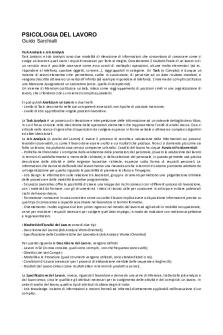Methods for Collecting Job Analysis Data PDF

| Title | Methods for Collecting Job Analysis Data |
|---|---|
| Course | Human Resource Analytics |
| Institution | University of Greenwich |
| Pages | 3 |
| File Size | 67.4 KB |
| File Type | |
| Total Downloads | 43 |
| Total Views | 143 |
Summary
Download Methods for Collecting Job Analysis Data PDF
Description
Methods for Collecting Job Analysis Data As discussed earlier, information is to be collected for job analysis. Such information may be collected by the trained job analysis, superiors concerned and job holders themselves. Job information is collected through the following methods:
1.
Participant Diary/Logs:
Workers can be to keep participant diary/long or lists of things they do during the day. For every activity he or she engages in, the employee records the activity (along with the time) in a log. This can provide you with a very comprehensive picture of the job, especially when it’s supplemented with subsequent interviews with the worker and his or her supervisor. This method provides more accurate information if done faithfully. However, it is quite time consuming. Further, each job holder may maintain records according to his own way which presents problems in analysis at later stage. Therefore, it has limited application. 2.
Interview:
There are three types of interviews you can use to collect job analysis data: individual interviews with each employee; group interviews with groups of employees having the same job; and supervisor interviews with one or more supervisors who are thoroughly knowledgeable about the job being analysed. The group interview is used when many employees are performing similar or identical work, since this can be a quick and inexpensive way of learning about the job. As a rule, the worker’s immediate supervisor would attend the group session; if not, you should interview the supervisor separately to get that person’s perspective on the duties and responsibilities of the job. 3.
Critical Incidents:
In this method, job holders are asked to describe incidents concerning the job based on their past experience. The incidents so collected are analysed and classified according to the job areas they describe A fairly picture of actual job requirements can be obtained by distinguishing between effective and ineffective behaviours of workers on the job. However, this method is time consuming.
The analyst requires a high degree of skill to analyse the contents of descriptions given by workers.
4.
Technical Conference Method:
This method utilizes supervisors with extensive knowledge of the job. Here, specific characteristics of a job are obtained from the “experts.” Although it is a good data gathering method, it often overlooks the incumbent worker’s perception about what they do on their job.
5.
Job Performance:
Under this method, the job analyst performs the job under study to get first-hand experience of the actual tasks, and physical and social demands of the job. This method can be used only for jobs where skill requirements are low and can be learnt quickly and easily. This is a time-consuming method and is not appropriate for jobs requiring extensive training.
6.
Functional Job Analysis:
Functional job analysis (FJA) is employee- oriented analytical approach of job analysis. This approach attempts to describe the whole person on the job. The main features of FJA include the following: • • • • 7.
The extent to which specific instruction are necessary to perform the task The extent to which reasoning, and judgment are required to perform the task The mathematical ability required to perform the task and The verbal and language facilities required to perform the task. Observation Method:
Using this method, a job analyst watches employees directly on the job. Observations are made on various tasks, activities, the pace at which tasks are carried out, and the way different activities are performed.
This method is suitable for jobs that involve manual, standardized, and short job cycle activities. This method also requires that the entire range of activities be observable, possible with some jobs. 8.
Questionnaires:
The method is usually employed by engineering consultants. Properly drafted questionnaires are sent out to jobholders for completion and are returned to supervisors. However, the information received is often unorganized and incoherent. The idea in issuing questionnaire is to elicit the necessary information from jobholders so that any error may first be discussed with the employee and, after corrections, may be submitted to the job analyst....
Similar Free PDFs

Ch. 3 - JOB Analysis Methods
- 4 Pages

Hypotheses + Collecting DATA
- 9 Pages

Basic Methods of Data Analysis
- 260 Pages

WS 03 Collecting Data KEY
- 16 Pages

Analysis methods
- 162 Pages

Job Analysis
- 5 Pages

Tools for multivariate data analysis
- 10 Pages

Traffic data collection methods
- 56 Pages

Task Analysis e Job Analysis
- 3 Pages

CH 1 Defining AND Collecting DATA
- 51 Pages
Popular Institutions
- Tinajero National High School - Annex
- Politeknik Caltex Riau
- Yokohama City University
- SGT University
- University of Al-Qadisiyah
- Divine Word College of Vigan
- Techniek College Rotterdam
- Universidade de Santiago
- Universiti Teknologi MARA Cawangan Johor Kampus Pasir Gudang
- Poltekkes Kemenkes Yogyakarta
- Baguio City National High School
- Colegio san marcos
- preparatoria uno
- Centro de Bachillerato Tecnológico Industrial y de Servicios No. 107
- Dalian Maritime University
- Quang Trung Secondary School
- Colegio Tecnológico en Informática
- Corporación Regional de Educación Superior
- Grupo CEDVA
- Dar Al Uloom University
- Centro de Estudios Preuniversitarios de la Universidad Nacional de Ingeniería
- 上智大学
- Aakash International School, Nuna Majara
- San Felipe Neri Catholic School
- Kang Chiao International School - New Taipei City
- Misamis Occidental National High School
- Institución Educativa Escuela Normal Juan Ladrilleros
- Kolehiyo ng Pantukan
- Batanes State College
- Instituto Continental
- Sekolah Menengah Kejuruan Kesehatan Kaltara (Tarakan)
- Colegio de La Inmaculada Concepcion - Cebu





